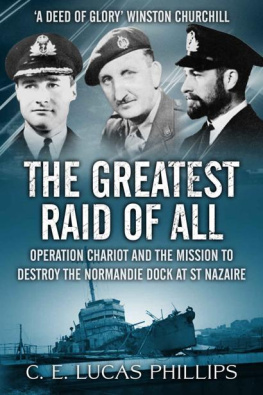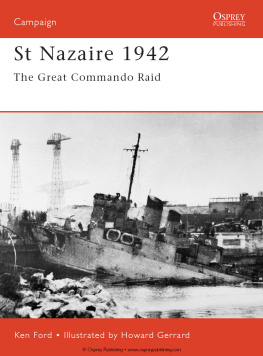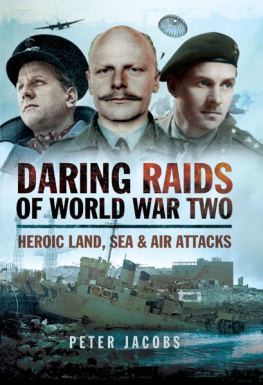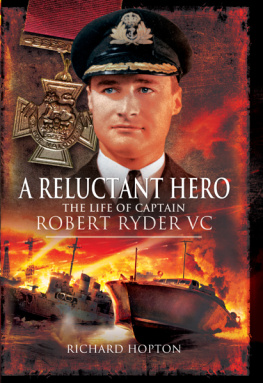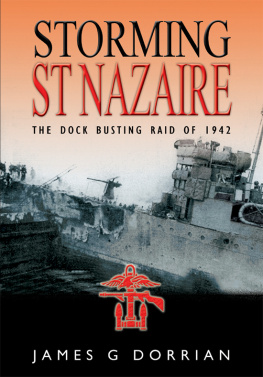THE GREATEST RAID OF ALL
C. E. Lucas Phillips
TABLE OF CONTENTS
AUTHORS NOTE
Having been associated with practically all combined operations, from two-man raids to the planning for Normandy, I have no hesitation in saying that the finest and most profitable of the lot was your raid on St Nazaire.
Thus Lord Louis Mountbatten, as he then was, wrote to Lieutenant-Colonel Charles Newman after Newmans release from captivity in 1945. Yet, of the many exploits of the war, of which this was perhaps the most daring and brilliant of all, few have received so little attention from the investigator. Indeed, no account, official or otherwise, has yet been published which is complete and wholly accurate, even the official casualty numbers being at fault. Captain Robert Ryders little book, The Attack on St Nazaire , gives an excellent short narrative and still better appreciation, but it is surprising that no full-dress account has yet been written.
The book now presented, accordingly, is an attempt to fill the gap and it will have failed in its purpose if it does not now show that the St Nazaire Raid shines with a lustre equal to that of the most brilliant of any small exploit of warfare. Small in numbers, but large in achievement. For the gallant 600 who sailed up the Loire on that cloudy March night in 1942, with guns to right and left and ahead of them, achieved a purpose out of all proportion to their small number and of an extent that was not fully realized until after the war was over. It would be inappropriate to repeat here the comparison made with Zeebrugge in the main text, but it is very apt to quote the verdict of Admiral of the Fleet Sir Charles Forbes in his introduction to Captain Ryders book.
Without in any way wishing to belittle Zeebrugge, wrote Sir Charles, one should now talk of St Nazaire instead.
These things will appear. On the other hand, no attempt has been made to minimize the less satisfactory features, such as the reluctance of the Admiralty to provide the essential ships, the unhappy collapse of the bombing support programme, the loss of command of the battle through failure of wireless communications and the severe, indeed the heartbreaking, losses among the vulnerable motor launches.
As far as possible, this book has been written entirely from original evidence, British, German and French. No existing account has been taken for granted. In this pursuit I have received generous help from Amphibious Warfare Headquarters and from Lieutenant-Commander P. K. Kemp and Commander M. G. Saunders (particularly for German records) of the Historical Section of the Admiralty. The French Embassy has also courteously assisted and the Librarian of the Imperial War Museum has expertly excavated in her rich soil. In addition to a large store of original documents, I have received personal narratives from fifty-three British and eleven German officers and men who participated in the planning or execution of the Raid, and in most instances these informants have seen and concurred in those portions of the manuscript that concerned them.
To all these informants, many of whom have put up with much cross-examination, I am very much indebted. For reasons of length, I have been most regretfully obliged to omit a large wealth of detail, particularly regarding the River Battle, the escapes and the preliminary planning, with which they have so generously supplied me.
I cannot possible enumerate, as I should like, all these contributors to the store of information, but for specially valuable or continuous help at many stages I owe particular thanks to Admiral of the Fleet the Earl Mountbatten of Burma, Lieutenant-Colonel S. W. Chant, OBE, MC (who has been a particularly valuable and resourceful aide in the hunt for information), Captain S. H. Beattie, RC, RN, Major R. K. Montgomery, MC, RN, Dr P. J. C. Dark, Major W. O. Copland, DSO, Mr R. O. C. Swayne, MC, Commander E. A. Burt, DSC, Mr R. C. M. V. Wynn, DSC, Commander D. M. C. Curtis, DSC, Mr T. W. Boyd, DSO, Mr G. R. Wheeler, MM, Major Anthony Terry, MC, Mr John Coste, DSC, and Mr I. L. Maclagan. For the planning and preparation I have been critically guided by Vice-Admiral J. Hughes-Hallett, CB, DSO, MP, Major-General J. C. Haydon, CB, OBE, DSO, Colonel R. D. Q. Henriques,. CBE, and Wing Commander The Marquess de Casa Maury, as well as by Earl Mountbatten himself. Mr H. E. Hewett, Secretary of the St Nazaire Society, aptly described by Earl Mountbatten as the most exclusive society in the world, has helped me to make contact with a great number of the gallant Charioteers in many parts of the world.
Among German informants, I am chiefly indebted to Kapitn zur See C. C. Mecke, Herr Edo Dieckmann, Dr Lothar Burhenne, Fregattenkapitn F. K. Paul, Kapitn zur See Moritz Schmidt and Dr Herbert Sohler.
Above all, however, I am in debt to Captain R. E. D. Ryder, VC, and Lieutenant-Colonel A. C. Newman, VC, OBE, TD, DL, for their continuous guidance at all stages and for their constructive criticisms of my draft manuscript throughout. Without their help the story of St Nazaire could not have been told.
From this mass of detailed evidence, official and personal, often contradictory, often incomplete or uncertain, I have done my best to give a true representation of the facts, weighing the evidence in the scales of judgment as best one can. In personal and minor detail, however, some points still remain indecisive, for in all the crowded and stirring events of a close action it is not always easy for the participants themselves to be entirely certain of what has occurred. If some small errors have crept in from such causes, this narrative will nonetheless, I hope, stand as witness to an aggregation of deeds of individual heroism that has seldom been excelled.
The title of the book is taken from Hilary St George Saunders, historian of the Commandos, in his book The Green Beret .
The ranks throughout are those appropriate to the time.
FOREWORD
By Admiral of the Fleet the Earl Mountbatten of Burma, KG
Of all the operations with which I was concerned in the late war, the successful raid on the battleship dock at St Nazaire is perhaps the one I am most proud to have been associated with. It was one of those actions which can only be attempted precisely because it must appear, to the enemy, to be absolutely impossible to undertake; and for this reason alone it required courage and determination of a quite unusual order to carry out. What is more, this complicated operation had been planned in greatest detail; and once the forces were committed each individual small ship and each little group of soldiers had to fight it out, guided by orders received at home, but entirely in the light of their own initiative.
I know of no other case in naval or military annals of such effective damage being inflicted so swiftly with such economy of force. For in less than half an hour from the moment the Campbeltown rammed, all the commandos chief demolition objectives were successfully achieved. This brilliant attack was carried out at night, under a vicious enemy fire, by a mere handful of men, who achieved, with certainty and precision, what the heaviest bombing raid or naval bombardment might well have failed to do. The great Normandie Dock was put out of action and was made useless to every kind of ship and, indeed, was to remain unusable for the next ten years or so. The Germans were prevented from being able to use the only dock on the Atlantic seaboard to which their great battleship Tirpitz could go, to repair damage sustained in raiding the Atlantic; in fact, this effectively prevented them from operating her against our convoy routes altogether. Thus the main object of the raid was brilliantly achieved.
Next page
